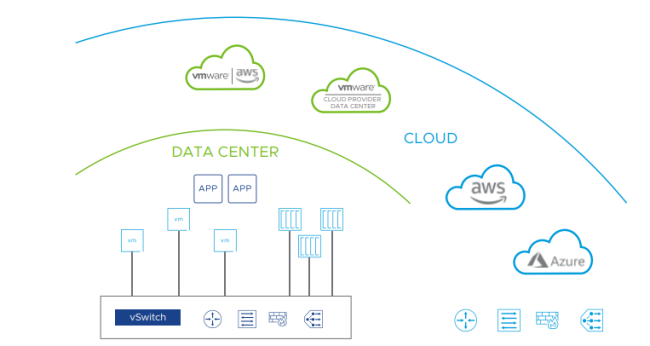Home > Networking Solutions > Converged and Hyperconverged Solutions > VxRail Networking Solutions > Guides > VMware Cloud Foundation on VxRail Multirack Deployment Using BGP EVPN - Part 2 of 2 > VMware NSX Data Center
VMware NSX Data Center
-
VMware NSX Data Center delivers virtualized networking and security entirely in software, completing a vital pillar of the Software Defined Data Center (SDDC), and enabling the virtual cloud network to connect and protect across data centers, clouds, and applications.
With NSX Data Center, networking and security are brought closer to the application wherever it is running, from virtual machines (VMs) to containers to bare metal. Like the operational model of VMs, networks can be provisioned and managed independent of the underlying hardware. NSX Data Center reproduces the entire network model in software, enabling any network topology—from simple to complex multitier networks—to be created and provisioned in seconds. Users can create multiple virtual networks with diverse requirements, using a combination of the services that are offered through NSX or from a broad ecosystem of third-party integrations ranging for next-generation firewalls to performance management solutions to build inherently more agile and secure environments. These servers can be extended to various endpoints within and across clouds.

Figure 3. NSX Data Center: Network Virtualization and Security Platform
VMware NSX Data Center delivers an entirely new operational model for networking that is defined in software, forming the foundation of the SDDC and extending to a virtual cloud network. Data center operators can now achieve levels of agility, security, and economics that were previously unreachable when the data center network was tied solely to physical hardware components. NSX Data Center provides a complete set of logical networking and security capabilities and services, including logical switching, routing, firewalling, load balancing, a virtual private network (VPN), quality of service (QoS), and monitoring. These services are provisioned in virtual networks through any cloud management platform using NSX Data Center APIs. Virtual networks are deployed non-disruptively over any existing networking hardware and can extend across data centers, public and private clouds, container platforms, and bare-metal servers.
